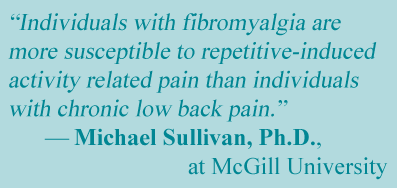Repetitive Activity & Fibro

You know that using the same muscle groups over and over causes pain to build up rapidly in these areas. Ideally, you need to take lots of rest breaks. You are not lazy, nor are you exaggerating your pain response to repetitive activity. But how do you get others to understand what it feels like to live in your fibromyalgia body?
A study by Michael Sullivan, Ph.D., at McGill University in Canada helps substantiate this escalating pain experience.* It also documents that movement-related pain is more severe for people with fibromyalgia compared to patients with chronic low back pain. And better yet, these differences between fibromyalgia and low back pain are not related to depression or fear of movement.
The repetitive task required patients to lift 18 canisters off a table in front of them (just hold it for a second, then place it down). The canisters were waist high and arranged in three rows. Those in the front row could be lifted without reaching or bending forward. Lifting the canisters in the second and third rows required stretching and strain on the arms and back. With each successive canister lift, the subjects rated their pain level and how heavy they perceived the canister to be (some were filled with more sand than others but they all looked identical).

Fibromyalgia patients reported more intense pain than the back pain patients after lifting the sixth through 18th canister. As the number of canisters lifted increased, so did the pain caused by the repetitive activity, and more so for the fibromyalgia group of patients. These differences were not due to lifting the canisters longer or faster, as both patient groups performed the lifting task with the same speed.
The study found that 28 percent of the 50 fibromyalgia patients experienced at least a one-third increase in pain levels going from the first to the 18th canister. Only 6 percent of the 50 back pain patients experienced a similar increase in pain with the repetitive lifting task.
“There were no indications that the fear of movement accounted for diagnosis-related differences in repetition-induced pain,” state the authors. Indeed, fear of movement was the same for both groups, so the greater pain in people with fibromyalgia could not be attributed to fear. However, the escalation of pain with repeat movement may explain why you struggle during the early phases of a fitness program that necessitates using the same muscles over and over again.
“The results of the present study show that individuals with fibromyalgia are more susceptible to repetitive-induced activity related pain than individuals with chronic low back pain,” conclude the study authors. “The findings are consistent with anecdotal accounts of the difficulties that individuals with fibromyalgia experience in the context of repeated physical activity.”
* Lambin DI, Sullivan MJL, et al. PAIN 152(6):1424-1430, 2011.